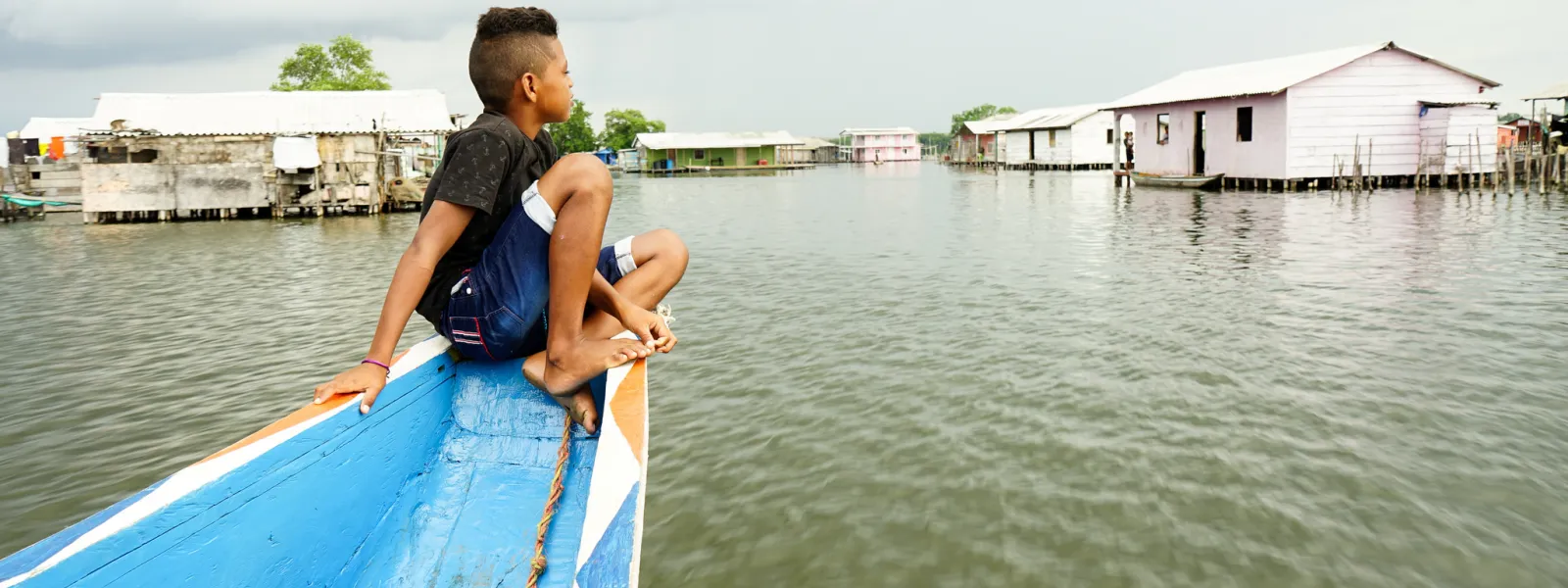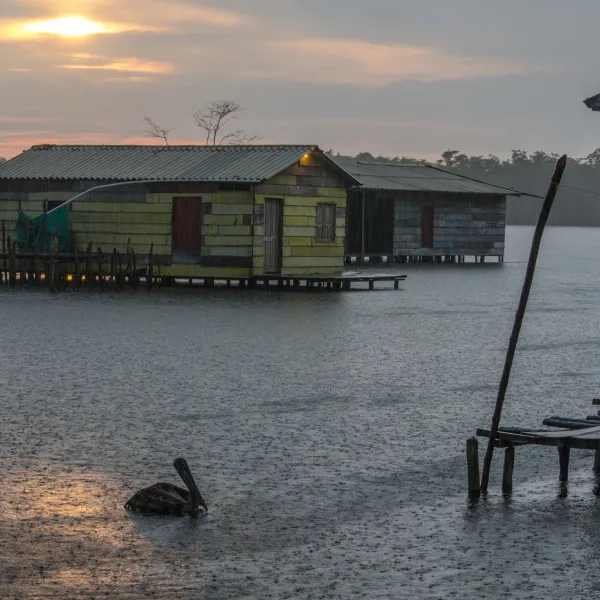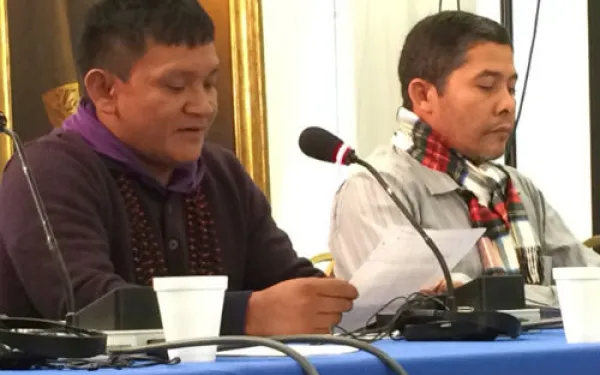
Project
Photo: Anna Laurie Miller / AIDAConserving the Ciénaga Grande de Santa Marta
Ciénaga Grande de Santa Marta, the largest and most productive coastal wetland in Colombia, covers 45,000 hectares. At the confluence of the Magdalena River and the Caribbean Sea, the site boasts an immense variety of flora and fauna, including mammals, birds and fish. Its southern tip is a beautiful sanctuary of mangroves, swamp and amphibious forest.
On the calm waters of the marsh stand the Ciénaga’s famous stilt villages, supported by pillars or simple wooden stakes and inhabited by local fishermen since 1800. In a place accessible only by water, many of the things we take for granted—being served a glass of water, quick access to a doctor—are considered luxuries. Residents depend on the natural world around them. Sadly, in recent years mass fish die-offs caused by the marsh’s degradation have threatened the livelihoods of 2,500 people who call the Ciénaga Grande home.
Illegal activities are destroying this vital ecosystem: intentionally set forest fires, deforestation of large tracks of land for agriculture and livestock, logging and burning of mangroves, and 27 kilometers of illegally built dikes.
This destruction not only devastates the local fishery; it also has global impact. Ciénaga Grande’s mangroves absorb large quantities of carbon dioxide from the atmosphere, aiding in the global fight against climate change.
The importance of the Ciénaga Grande has been recognized both nationally – the Sanctuary of Flora and Fauna Ciénaga Grande de Santa Marta is a national park – and internationally: UNESCO’s Man and the Biosphere program declared the lagoon a biosphere reserve; and the Ciénaga Grande is listed as a Wetland of International Importance under the Ramsar Convention, an intergovernmental treaty for the protection of wetlands.
AIDA and our partners are advocating for the Colombian government to fulfill its national and international obligations to protect the Ciénaga Grande. After all, millions of animals, the local community, and our global climate depend on it.
Partners:

Related projects

Frustration to hope: Finding the drive to continue from those you help
By María José Veramendi Villa, senior attorney, AIDA, @MaJoVeramendi I can get frustrated in my work as an environmental and human rights lawyer. It is frustrating to explain that the work we do on cases of human rights violations may not produce immediate results. It is frustrating to know that our work is a struggle that can take years to find justice for victims and induce change in state policies and our societies. It is frustrating to watch programs designed to protect human rights come under the influence of political interests. The dearth of resources for pursuing these cases is also frustrating. So too are the long waits for justice – or injustice. So what do we do when we get discouraged? My answer is to return to the origins, the basics and the very reason for our struggle and commitment: the victims. I relearned this lesson in March. On a trip to Washington D.C., I met two Brazilian fighters for the cause of their communities: Alaíde Silva and Josías Manhuary Munduruku. Alaíde had traveled for days from Buriticupu, a municipality in the northeastern state of Maranhão, and Josías from Jacareacanga, a municipality in the northern state of Pará, to participate in a hearing (in Spanish and Portuguese) before the Inter-American Commission on Human Rights. They came to present information on how Brazilian judges are continuing to use a law from the country’s 1964-85 dictatorship to violate their right to access to justice. The law is called Security Suspension. It allows the federal government to request the suspension of judicial rulings. The government has used Security Suspension to invalidate rulings that favor the rights of indigenous peoples and other communities against the development of mega-projects like the Belo Monte hydropower dam in the Amazon. The government can do this on the basis that any adverse rulings to “development” projects are threats to national security or to social and economic order. At the hearing, Josías described an imminent threat to the Munduruku indigenous community of 11,000 people in 118 villages. The Brazilian government plans to build a hydropower complex (in Spanish) on the Tapajós River and its tributaries—and has not followed a law requiring it to consult the Munduruku and to obtain their prior, free and informed consent. He said flooding from the project threatens to devastate his people’s land and the survival of their community and culture. He explained how a judge revoked a favorable court decision for his people, allowing the project to continue in open violation of their rights. “We want respect for our land, our river, our sacred sites, our cemetery. And want to be consulted!” Josías said. Alaíde spoke about a similar plight. He explained how Vale, a Brazilian mining company, is enlarging the Carajás Railroad to the detriment of 1.7 million people in 27 municipalities in Maranhão and Pará and in at least 100 indigenous, Afro-descendants, peasant and urban communities on the banks of the railway. The railroad stretches 900 kilometers from the Carajás mines in Pará to the Ponta da Madeira Maritime Terminal in Maranhão. It transports iron, manganese, copper and coal. With the expansion, Vale will duplicate 115 kilometers of the line to increase transport capacity and the flow of minerals. Alaíde said the impacts are vast. These range from the noise pollution caused by the grinding of the train wheels on the tracks and from the train horn, to the running over of people and animals, to the displacement of communities, villages and families without fair compensation. Alaíde provided details on how Vale terrorizes the population, co-opts leaders, intimidates people and spies on social movements, all in the name of meeting its own interests. As with Tapajós, Security Suspension was used to revoke a court ruling that had favored the communities. That decision had ordered Vale to suspend construction and conduct an environmental impact assessment with a detailed analysis of all the existing indigenous and Afro-descendant communities along the railroad. But with Security Suspension, this ruling was overturned with the argument that suspending the project would affect the economic interests of the state. These are just two examples of the impact of Security Suspension. There are many more instances in which the rights of communities and people have been affected by major “development” projects justified by “economic interest, public order and safety.” We hope that cases like these will expose the impact that Security Suspension has on the human rights of hundreds of people and communities, and we hope that this will drive international organizations to call on Brazil to change this legal instrument. Thanks to everyone who worked so hard to make the hearing possible. Thanks to our colleagues in Brazil without whose work and commitment Alaíde and Josías would never have been able to make the long journey. And thanks to these two Brazilian human rights fighters for a lesson that drives away the fog of frustration and allows the sun to shine again. I want to dedicate this post to my dear former colleague Joelson Cavalcante, who recently left this world to become a being of light. With him I visited the Xingu River in the Brazilian Amazon for the first time, and I will never forget his happiness and his big smile when, after a year outside his country, he could once again swim in those waters. In his memory, the fight continues.
Read moreCOP20: A chance to fight climate change
The world is poised for more poverty, hunger and disease as flooding, heat waves, storms and droughts increase. This is how the newest report of the the United Nations Intergovernmental Panel on Climate Change describes humanity´s near future. That’s why AIDA is helping Latin American policymakers to influence decisions about climate change responses at the highest levels of international law. We’re building their capacity for influence by developing recommendations and disseminating information. This year Latin America has the best opportunity yet to put its needs on the international climate change agenda. In December, Lima will host the main session of climate negotiations, the 20th Conference of the Parties to the UN Framework Convention on Climate Change (COP20). The event’s mission is to advance the draft of a new binding climate agreement to be signed at the Paris climate conference in 2015. To make the most of this opportunity, AIDA is supporting policymakers – government officials, negotiators and members of international financial institutions – and civil society organizations. Our objectives are to help them participate more effectively in the climate negotiations, to educate them about options for improvements in international law, and to encourage them to create solutions and press their governments to take immediate action. In March, we took part in Climate Change: Progress and Prospects, an international forum held in the Peruvian Congress. Peru is considering creating a climate change bill, and at the event we shared our experiences in international climate finance. We highlighted the need for Latin American institutions to improve their ability to access funds for climate change adaptation and mitigation projects. We’re also advocating a commitment to long-term financing as a chief component of the new climate agreement that will be discussed at COP20. If countries know that economic resources will become and remain available, they can plan viable actions to help communities most vulnerable to climate change. In February, AIDA and our partner organizations held a webinar on the Green Climate Fund (GCF), a financial mechanism of the UN Framework Convention on Climate Change. The GCF was founded to mobilize large amounts of public and private money to support climate change responses in developing countries. AIDA is closely monitoring the GCF to make sure that its contribution is effective. Your renewed support will help us to do even more to generate effective international actions that reduce the severity of climate change. As we actively prepare for COP20 and continue our efforts to promote sustainable energy alternatives at the regional level, we will keep you informed of our progress. Thank you!
Read moreColombia’s Ministry of Environment unveils the demarcation of the Santurbán Páramo without specifying details of the measurements
With the water supply of millions of people at risk, we urge the ministry to publish details of the demarcation and ensure that this fragile ecosystem remains free of large-scale mining operations. Bogotá, Colombia. Colombia’s Ministry of Environment announced the delimitation of the Santurbán Páramo, a high-altitude wetland ecosystem that supplies water to millions of people in the country. While the ministry disclosed some aspects of the measure to the media, it has not released full details. These include the full extension of the demarcation, exact coordinates and which mining operations are inside or outside of the defined area. The ministry stated that the protected area would increase from 11,000 hectares to 42,000 hectares in the department of Santander. However, according to the Colombian Humboldt Institute’s atlas, the ecosystem has a surface area of at least 82,000 hectares in the departments of Santander and North Santander. “We do not know if the protected area covers the total area of the páramo in both departments. Nor do we know the coordinates or what mining titles will be affected. We do not even know if there is a written draft of the official decision. This seems incompatible with the right to access accurate and impartial information, as enshrined in the Colombian Constitution,” said lawyer Carlos Lozano-Acosta of the Interamerican Association for Environmental Defense (AIDA). The páramo of Santurbán supply water to nearly two million people, including the cities of Bucaramanga and Cúcuta. As is common for this ecosystem, the páramo of Santurbán has a diversity of flora and fauna and is important for storage of atmospheric carbon, helping to mitigate climate change effects. According to the law, the demarcation of this ecosystem should be formally and clearly defined in order to prevent harmful activities such as large-scale mining, which could cause irreversible damage. According to the Ministry, companies with mining concessions and environmental licenses will remain in Santurbán. The ministry said that the demarcation affects only 10 of 29 mining titles, including those of the Canadian firm Eco Oro Minerals. It did not provide any further details. Without the exact coordinates of the ecosystem, it is not possible to know precisely the extent of the demarcation and the ongoing threat that large-scale mining poses to this water source. Eco Oro has threatened to pursue legal action if the final decision affects their investment, presumably basing its arguments on the free trade agreement between Colombia and Canada that would allow the company to sue Colombia in an international tribunal. “Colombians should not pay a company for investing where it should not, much less if it threatens their water supplies. Colombian law prohibits mining in páramos. We call on Eco Oro to respect Colombians’ right to water instead of threatening legal action to protect their investment,” said Jennifer Moore of MiningWatch Canada. Kristen Genovese of the Centre for Research on Multinational Corporations (SOMO) said, “Eco Oro is not only violating Colombian law with regard to mining in the páramo, but the project is inconsistent with the social and environmental standards of the International Finance Corporation (IFC), which is financing the project. We believe that an investigation now underway regarding the IFC’s investment in Eco Oro will confirm our analysis.” According to the Ministry, the decision will not be adopted immediately, and no date has been set to implement it. “The participation of citizens in the demarcation process has not been adequate. We do not know, for example, if the Ministry used rigorous technical studies provided by the Humboldt Institute. Nor is much known about how public participation took place regarding this decision,” said Miguel Ramos of the Committee for the Defense of Water and the Santurbán Páramo. Also unknown is how Andean forest ecosystems, or cloud forests, located at altitudes of 2,200 to 2,600 meters above sea level, will be protected and managed. These are also vital to ecosystem health and water regulation. Similar to Eco Oro’s approach in Santurbán, the mining company AUX plans to carry out underground mining in these ecosystems. To date, more than 19,000 people have signed a petition (in Spanish) urging the Colombian government to protect the water of Santurbán according to scientific criteria. The government received (in Spanish) 16,000 of those signatures in November 2013. Organizations and environmentalists have also asked (in Spanish) the Colombian government to properly define the limits of the páramo ecosystem. The demarcation of Santurbán will set a precedent for protecting the country’s other páramos. Colombia is home to half of the páramos in the world, which supply water to 85% of its population. The demarcation process must take into account the minimum projected area of the páramo in the Humboldt Institute’s Atlas and its technical studies at a scale of 1:25:000. “If the Santurbán Páramo is adequately defined, it would set an important precedent for the protection of all the páramos. This would lead the way, taking another step toward respecting the right to water of all Colombians” said Carla Garcia Zendejas of the Center for International Environmental Law (CIEL). AIDA, CIEL, the Committee for the Defense of Water and the Santurbán Páramo, MiningWatch Canada and SOMO -- as allied organizations -- ask Eco Oro to refrain from threats of legal action in an attempt to influence the demarcation of the páramo, and ask the Colombian government to provide full, truthful, and impartial information about the process and final decision.
Read more